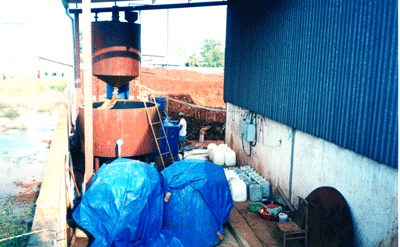Waste from bauxite ore can filter water?
Practicing aluminum extraction from bauxite ore generates a large amount of red mud, a hazardous waste. However, it is this sludge that can be used to treat industrial wastewater into type A water.
This is a new wastewater treatment method by engineer Nguyen Lam Anh, currently working at a technical engineering company based in Ho Chi Minh City.
'Toxic poisoning'
To separate a ton of aluminum from bauxite ore, the amount of alkaline red mud discharged into the environment is about 1.5 tons. This type of mud is very slow to solidify so it must be more than 20 years of storage to move on the mud.

Handling red mud collected on chloride alum.Photo: Thai Ngoc.
The characteristic of red mud is that it is smaller than 1 mm in size. Therefore, dry sludge is easy to disperse dust into the air causing pollution, frequent contact with this dust causes skin and eye diseases. The waste water from the sludge is in contact with the skin causing harmful effects such as caustic skin, causing loss of sebum, making the skin dry, rough, hard, cracked, painful, possibly swelling, pus ulcers in the skin tear .
In particular, the ability to contaminate groundwater is very high when storing mud in large quantities for a long time. This sludge disperses odors, chemical vapors contaminate and corrode materials.
Until now, solutions to handle this type of waste have not had a positive 'output'. As for high-quality wastewater such as dyeing, tanning, printing ink, concentrated industrial wastewater, the treatment is also difficult and very expensive.
Research by engineer Nguyen Lam Anh is based on the theory of 'poison poisoning'. Based on the characteristics of the red mud consisting of two main components, about 40-50% iron oxide and 18-20% aluminum oxide, it is possible to settle and flocculate, so the author mixed some other components to collect chloride alum.
After that, Lam Anh engineers put this amount of alum into textile wastewater, tanning . to hydrolyze to form flocculation (cotton mud aluminum hydroxide and iron hydroxide). With just one step, this sludge is allowed to pass through the settling tank and it is possible to discharge wastewater to the natural environment.
Effective up to 90%
Chlorinated alum prepared from red mud has been used to flocculate dyed sewage at Thanh Cong Textile Factory, the reduction efficiency is 88%. Similarly, with the concentrated wastewater of Long Thanh Industrial Park (Dong Nai), the reduction efficiency reaches 89%. In Trang Bang Industrial Park (Tay Ninh) is 92%, meeting the industrial standard of Type A.
Not only is wastewater treatment effective, but this method also has the advantage of cost of wastewater treatment.
Previously, it was estimated that to treat 1 m3 of textile wastewater, concentrated industrial wastewater meeting the A-level wastewater standards, costing VND 6,000 per m3. However, taking advantage of this source of red mud waste to treat "fastidious" wastewater, the cost is only about 4,200 VND.
Associate Professor, Dr. Nguyen Van Phuoc, Director of the Ho Chi Minh City Institute of Natural Resources and Environment (also a guide for a master thesis for engineer Nguyen Lam Anh), evaluated and utilized red mud during production. It is feasible to produce aluminum from bauxite ore as an input material for wastewater treatment, with very high practical applications. In particular, red mud is very 'specific' in handling the colors of the above-mentioned wastewater because 'color processing is very difficult'.
Now Professor Phuoc and his colleagues use red mud of Tan Binh chemical factory (Ho Chi Minh City) to produce chloride alum to treat pollution of industrial wastewater. Each month consumes from a few tons to tens of tons. He said that in addition to treating wastewater, red mud could also adsorb sulfur dioxide gas; as arsenic reducing agent in water .
- Hungarian bauxite waste threatens wide-area pollution
- Generators from waste water
- Hungarian incidents and bauxite lessons with Vietnam
- Australia finds new technology that filters contaminated water in minutes
- How to solve the cigarette filter of Australian scientists
- Use red mud to treat metal pollution in waste water
- Switzerland: 43 kg of gold from wastewater
- Lack of water, science race to filter seawater into fresh water
- Purisoo: Portable water filter can help you drink clean water anywhere
- The 15-year-old has an initiative to clean water with corn cobs
- Filter water with sanitary pads - vital tips when you don't have clean water to use
- The 12-year-old genius invented a plastic waste filter in the ocean
 Is the magnetic North Pole shift dangerous to humanity?
Is the magnetic North Pole shift dangerous to humanity? Washington legalizes the recycling of human bodies into fertilizer
Washington legalizes the recycling of human bodies into fertilizer Lightning stone - the mysterious guest
Lightning stone - the mysterious guest Stunned by the mysterious sunset, strange appearance
Stunned by the mysterious sunset, strange appearance